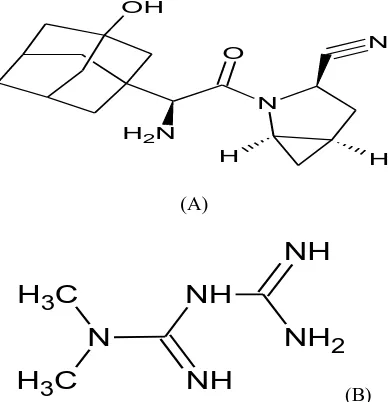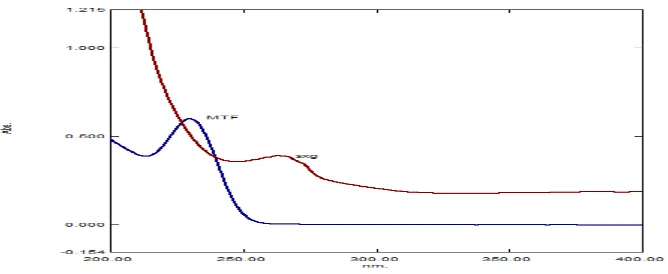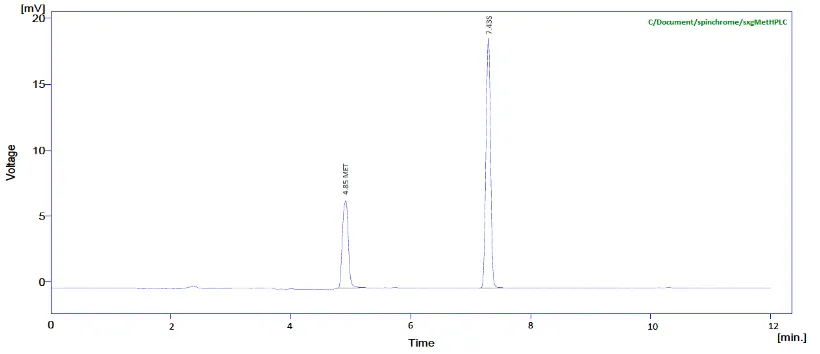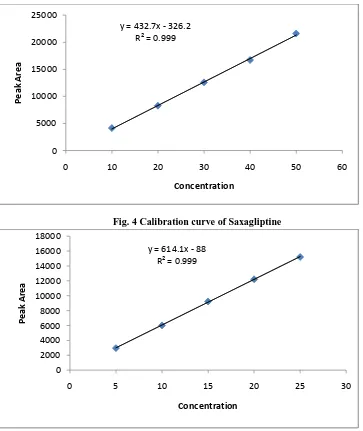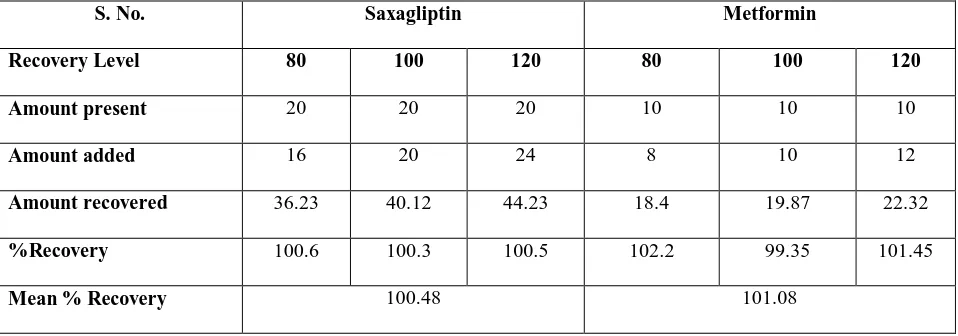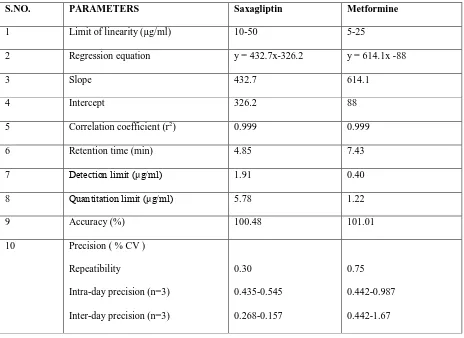AJPRHC
Research Article
SIMULTANEOUS ESTIMATION OF SAXAGLIPTIN HYDROCHLORIDE AND METFORMIN HYDROCHLORIDE IN ACTIVE PHARMACEUTICAL INGRIDENT BY RP-HPLC
NYOLA NARENDRA*1 GOVINDASAMY JEYABALAN2 For Author affiliations see end of the text
This paper is available online at www.jprhc.in
ABSTRACT
A new simple, accurate, precise and reproducible RP-HPLC method has been developed for the simultaneous estimation of Saxagliptin and Metformin in bulk drug form using C18 column (Phenomenex, 250 x 4.6 mm, 5 μm) in isocratic mode. The mobile phase consisted of 0.02M Potassium dihydrogen phosphate (KH2PO4), Acetonitrile, Methanol in the ratio of 50:25:25 (v/v/v) at pH 4.3. The detection wavelength was carried out at 240 nm. The method was linear over the concentration range for Saxagliptin 10-50μg/ml and for Metformin 5-25 μg/ml. The recoveries of Saxagliptin and Metformin were found to be 100.48and 101.1% respectively. The validation of method was carried out utilizing ICH-guidelines. The described HPLC method was successfully employed for the analysis of pharmaceutical formulations containing combined dosage form.
Key Words: - Saxagliptine Metformine, Simultaneous estimation, RP-HPLC
INTRODUCTION
Saxagliptin (SXG) is chemically (1S, 3S, 5S)-2-[(2S)-2-Amino-2-(3 hydroxytricyclo [3.3.1.13, 7] dec-1-yl) acetyl]-2-azabicyclo [3.1.0] hexane-3-carbonitrile previously identified as BMS-477118.This is new oral hypoglycemic agent of the new dipeptidyl peptidase- 4 (DPP-4) inhibitor class of drugs. The empirical formula is C18H25N3O2, H2O and the molecular weight is 333.431-5 .The structural formula is:
OH
N O
N H2
N
H H
(A)
N
NH
NH
NH
2NH
C
H
3C
H
3Saxagliptin recently approved for the treatment of type-2 diabetes mellitus. It has been used in conjunction with exercise and diet to improve glycaemic control in patients with type 2 diabetes and is to be used with metformin, a sulphonylurea or pioglitazone when blood sugar levels are not adequately controlled by one of these agents alone 6-12
. Literature survey reveals that the drug can be estimated only by LC-MS/MS13, Spectrophotometric method14 have been reported.
Metformin Hydrochloride(MTF) (C4H11N5.HCl) is 1, 1-dimethylbiguanidine monohydrochloride (Fig 1), is an anti-diabetic drug from the biguanide class of oral hypoglycaemic agents, given orally in the treatment of non –insulin-dependent diabetes mellitus15 .Major action of metformin HCl in increasing glucose transport across the cell membrane in skeletal muscle16-17 . Several analytical methods based on UV 18-20, Spectroflourimetry21, RP-HPLC 22-30
,HPTLC 31and LC-MS/MS32 was reported for the determination of metformin. Although literature survey reveals that various methods were reported for Saxagliptin and Metformin both for single estimation and in combination with others drugs, but no estimation method has been reported for the analysis of these drugs in combination.
EXPERIMENTAL
Apparatus
The liquid chromatographic system consists of shimadzu 20 AT with UV-VIS detector, binary pump and rheodyne injector valve with 20 μl fixed loop. The analytes were monitored at 240 nm. Chromatographic analysis was performed on Phenomenex C18 column having 250 mm× 4.6 mm i.d. and 5 μm particle size. Chramotagram were automatically obtained by spinchrome system software.
Reagents and Materials
All chemicals and reagents were used of AR grade. Authentic of SXG and MTF were obtained as gift samples from Astra Zeneca Pharma India Ltd.
Selection of detection wavelength
Solutions of drug were scanned over the range of 200-400 nm. It was observed that both the drugs showed considerable absorbance at 274 nm for SXG and 231nm for MTF .the Isobestic point of both drugs was found to be 240nm.( Fig. 2 )
Fig 2 Isobestic point of Saxagliptin and Metformin
Chromatographic Conditions
Preparation of standard solution
SXG and MTF were weighed (100 mg each) and transferred to two separate 100ml volumetric flasks and dissolved in 50 ml of HPLC grade water and make up the volume up to the mark with water and the final concentration of solution containing 1000 µg/ml of SXG and MTF.
Preparation of working standard
Aliquot from the stock solutions of SXG and MTF were appropriately diluted with distilled water to obtain working standard of SXG and MTF.
METHOD DEVELOPMENT
Lots of mobile phase and there different proportions were tried and finally was selected as 0.02M Potassium dihydrogen phosphate (KH2PO4), Acetonitrile, Methanol in the ratio of 50:25:25 (v/v/v) at pH 4.3 appropriate mobile phase which gave good resolution and acceptable system suitability parameters. The chromatogram of working standard solution is shown in fig 3.
Fig 3 HPLC chromatogram of Saxagliptin and Metformin.
Linearity
Fig. 4 Calibration curve of Saxagliptine
Fig. 5 Calibration curve of Metformin Precision
The repeatability studies were carried out by estimating response of SXG (20 µg/mL) and MTF (10µg/mL) five times .The intra-day and inter-day precision studies were carried out by estimating the corresponding responses five times on interday and intraday for three different concentrations of SXG (10, 30, 50 µg/ml) and MTF (10, 15, 20 µg/ml) .It is expressed as the percentage coefficient of variation (% CV) which is calculated as per the following expression.
% CV = (standard deviation / mean) x 100.
Accuracy
Recovery assessment was obtained by using standard addition technique which was by adding known quantities of pure standards at three different levels in 80%, 100% and 120% to the pre analysed sample formulation. From the amount of drug found, amount of drug recovered and percentage recovery were calculated which sense to conformation that the proposed method was accurate.
y = 432.7x - 326.2 R² = 0.999
0 5000 10000 15000 20000 25000
0 10 20 30 40 50 60
P
ea
k
A
rea
Concentration
y = 614.1x - 88 R² = 0.999
0 2000 4000 6000 8000 10000 12000 14000 16000 18000
0 5 10 15 20 25 30
P
e
ak
A
rea
Table 1 Recovery study
S. No. Saxagliptin Metformin
Recovery Level 80 100 120 80 100 120
Amount present 20 20 20 10 10 10
Amount added 16 20 24 8 10 12
Amount recovered 36.23 40.12 44.23 18.4 19.87 22.32
%Recovery 100.6 100.3 100.5 102.2 99.35 101.45
Mean % Recovery 100.48 101.08
Detection Limit and Quantitation Limit
The detection limits were found to be 1.91µg/ml and 0.40µg/ml for SXG and MFT respectively. The quantitation limits were found to be 5.78µg/ml and 1.22µg/ml for Saxagliptin SXG and MFT respectively. These values indicate that the method is sensitive.
Specificity
The method was determined as specific by comparing test results obtained from analyses of sample solution containing placebo ingredients with that of test results those obtained from analyses of standard solution.
RESULTS AND DISCUSSION
The present work done on this combination comprises a simple, precise and accurate method by reverse phase high performance liquid chromatography. An attempt has been made to estimate SXG and MTF by RP-HPLC. Calibration curve depicting the linearity and range for SXG and MTF were determined from mixed standards and were found to be of the order10-50 µg /ml of SXG and 5-25 µg /ml of MTF. The retention times 4.85 minutes for MTF and 7.43 minutes for SXG. The results obtained from HPLC method were reproducible and encouraging. The values percentage deviation was within limit (>2%) and recovery close to 100% indicating reproducibility and accuracy of method.
CONCLUSION
Proposed study describes method for the estimation of SXG and MTF combination in mixture. The method was validated and found to be simple, sensitive, accurate and precise as per ICH guidelines .The method was successfully used for determination of drugs in their pharmaceutical formulation.
ACKNOWLEDGMENTS
Table 2: Analytical parameters
S.NO. PARAMETERS Saxagliptin Metformine
1 Limit of linearity (µg/ml) 10-50 5-25
2 Regression equation y = 432.7x-326.2 y = 614.1x -88
3 Slope 432.7 614.1
4 Intercept 326.2 88
5 Correlation coefficient (r2) 0.999 0.999
6 Retention time (min) 4.85 7.43
7 Detection limit (μg/ml) 1.91 0.40
8 Quantitation limit (μg/ml) 5.78 1.22
9 Accuracy (%) 100.48 101.01
10 Precision ( % CV ) Repeatibility
Intra-day precision (n=3) Inter-day precision (n=3)
0.30 0.435-0.545 0.268-0.157
0.75 0.442-0.987 0.442-1.67
Reference:-
1. Onglyza Product information. Bristol-Meyers-Squibb. Princeton New Jersey, USA. 1st July 2009. Available at: http://packageinserts.bms.com/pi/pi_onglyza.pdf (cited 1st August 2010).
2. Australian Drug Evaluation Committee Recommendations. Australian Government Department of Health and Aging, January 2010. Available at: http://www.tga.gov.au/docs/ html/adec/adec0267.htm (cited 30th Sept 2010)
3. Deacon CF, Holst JJ., 2009 ,Saxagliptin: a New Dipeptidyl Peptidase-4 Inhibitor for the Treatment of Type 2 Diabetes, Adv Ther,26(5),488-499.
4. Robertson JG. ,2005, Discovery and Preclinical profile of Saxagliptin (BMS-477118): A highly potent, long-acting, orally active dipeptidyl peptidase IV inhibitor for the treatment of type 2 diabetes , J Med Chem,48(15), 5025- 37.
5. Kania, DS, Gonzalvo JD, Weber ZA, 2011 ,Saxagliptin: A Clinical Review in the Treatment of Type 2 diabetes mellitus, Clin Ther,33,1005-1022.
6. Deanna KS., Jasmine GD., Zachary WA., Kulasa K., Edelman S,2010,Saxagliptin: the evidence for its place in the treatment of type 2 diabetes mellitus, Core evidence,5,23-37.
7. Tahrani AA, Piya MK., Barnett AH, 2011, Saxagliptin: a New DPP-4 Inhibitor for the treatment of Type 2 diabetes mellitus, Adv Ther, 26(3), 249-262.
9. Singh S., Sethi S., Khanna V.,Benjamin B.,Kant R., Sattigeri J., Bansal VS, Bhatnagar PK., Davis JA.,2011, A potent, selective and slow-binding inhibitor of dipeptidyl peptidase-IV for the treatment of type 2 diabetes ,Eur J Pharmaco,652, 157-163.
10. Sherwyn L.,Schwartz MD.,2010, Treatment of Elderly Patients with type 2 diabetes mellitus: A Systematic Review of the Benefits and Risks of Dipeptidy l Peptidase-4 Inhibitors, Amer.J Geria Pharmacothera, 8, 405-418.
11. 11 Hollander P., Jia L.,Allen E., Che R.,2009, Saxagliptin Added to a Thiazolidinedione Improves Glycemic Control in Patients with type 2 diabetes and Inadequate Control on Thiazolidinedione Alone, J Clin EndocrinolMetab,94(12),4810 -19.
12. Yang W.,Pan C.,Tou C.,Zhao J., Nilsson IG.,2011, Efficacy and safety of saxagliptin added to metformin in Asian patients with type 2 diabetes mellitus: A randomized controlled trial, Dia Res Clin Pra,5 3(1): 1-8.
13. Hess C., Musshoff F., Madea B., 2011, Simultaneous identification and validated quantification of 11 oral hypoglycaemic drugs in plasma by electrospray ionisation liquid chromatography–mass spectrometry, Anal Bioanal Chem, 400, 33-41.
14. Kalaichelvi R, Jayachandran E,2011, Validated Spectroscopic method for the estimation of Saxagliptinin pure and from tablet formulation, Int J Pharm Pharm Sci,3, 179-180.
15. Campbell DB, Lavielle R, Nathan C., 1991, The mode of action and clinical pharmacology of gliclazide: a review, Diab Res Clin Prac, 14, S21-S36.
16. Moses R., 2009, Fixed combination of repaglinide and metformin in the management of type 2 diabetes, Diabetes, Metabolic syndrome and obesity: Targets and Therapy ,Dovepress, open access to scientific and medical research,2,101-9.
17. Tripathi K.D. Essential of Medical Pharmacology, 2003, 5th Edn, Jaypee Brothers Medical publisher New Delhi. pp: 515-516.
18. Hassasaad S.M., Mahmoud WH., Elmosallamy MA, Othman AH.,1999,Determination of metformin in pharmaceutical preparations using potentiometry, spectrofluorimetry and UV–visible spectrophotometry, Anal Chimic ,1999, 378(1-3),299-311.
19. Patil S.S., Bonde C. G.,2009, Development and Validation of analytical method for Simultaneous Estimation of Glibenclamide and Metformin HCl in Bulk and Tablets using UV visible spectroscopy, Int J ChemTech Res,1(4): 905-909.
20. Lakshmi KS, Rajesh T, Sharma S, Lakshmi S, 2009,Development and Validation of Liquid Chromatographic and UV Derivative Spectrophotometric Methods for the Determination of Metformin, Pioglitazone and Glimepiride in Pharmaceutical Formulations, Der Pharma Chemica, 1 (1),238-246. 21. Freddy H. Havaldar, Dharmendra L.Vairal., 2010 Simultaneous estimation of metformin hydrochloride,
rosiglitazone and pioglitazone hydrochloride in the tablets dosage form., Int J AppBio Pharm Tec, 1(3),1000-1005.
22. AbuRuz, S., Millership J, McElnay J., 2005, The development and validation of liquid chromatography method for the simultaneous determination of metformin and glipizide, gliclazide, glibenclamide or glimperide in plasma, J Chromatogr B, 817(2),277-286.
23. Jain D, Jain S, Jain D ,Maulik A.,2008, Simultaneous Estimation of Metformin Hydrochloride, Pioglitazone Hydrochloride, and Glimepiride by RP-HPLC in Tablet Formulation .J Chromatogr Sci,46,501-504.
24. Lakshmi KS, Rajesh T,Sharma S.,2009,Simultaneous determination of metformin and pioglitazone by reversed phase HPLC in pharmaceutical dosage forms, Int J Pharm Pharm sci, 1(2), 162-166.
25. Alexandar S, Diwedi R, Chandrasekar M.,2010, A RP-HPLC method for simultaneous estimation of metformin and pioglitazone in pharmaceutical formulation, Res J Pharm Bio Chem Sci, 1(4), 858-866. 26. Florentin T, Monica A., 2007 Specificity of an analytical HPLC assay method of metformin
27. Ranetti M, Ionescu M, Hinescu L, Ionica E,Anuţa V, Aurelian E. et al.,2009,Validation of a HPLC method for the simultaneous analysis of metformin and gliclazide in human plasma, Farmacia, 57 (6), 729-735. 28. Pawar S, Meshram G, Jadhav R,Bansal Y.,2010,Simultaneous determination of Glimepiride and Metformin
hydrochloride impurities in sustained release pharmaceutical drug product by HPLC , Der Pharma Chemica,2(4), 157-168.
29. Havele S, Dhaneshwar S., 2010, Development and validation of a HPLC method for the determination of metformin hydrochloride, gliclazide and piogliglitazone hydrochloride in multicomponent formulation. Webmed central pharmaceutical sciences,1(10):wmc001078
30. Al-Rimawi F, 2009 Development and validation of an analytical method for metformin hydrochloride and its related compound (1-cyanoguanidine) in tablet formulations by HPLC-UV, Talanta, 79(5),1368-71. Epub 2009 Jun 9.
31. Havele S, Dhaneshwar S., 2010, Estimation of Metformin in Bulk Drug and in Formulation by HPTLC, J Nanomedic Nanotechnolo, 1: 102.doi:10.4172/2157-7439.1000102.
32. Georgita C, Albu F, David V, Medvedovici, 2007, A. Simultaneous assay of metformin and glibenclamide in human plasma based on extraction-less sample preparation procedure and LC /(APCI)MS. J Chromatogra B, 854(1-2),211-218.
AUTHORS AFFILIATION AND ADDRESS FOR CORRESPONDENCE
1. Department of Pharmaceutical Sciences, Shridhar University, Pilani, Rajasthan, India.
